Influencing and Making Decisions - Tools and Styles
VerifiedAdded on 2023/06/11
|16
|3242
|459
AI Summary
The report talks about different styles of decision making and tools used for decision making. It provides a comprehensive understanding of the decision making process and tools used for decision making. The report also reflects on the author's personal decision making style and compares it with other styles.
Contribute Materials
Your contribution can guide someone’s learning journey. Share your
documents today.
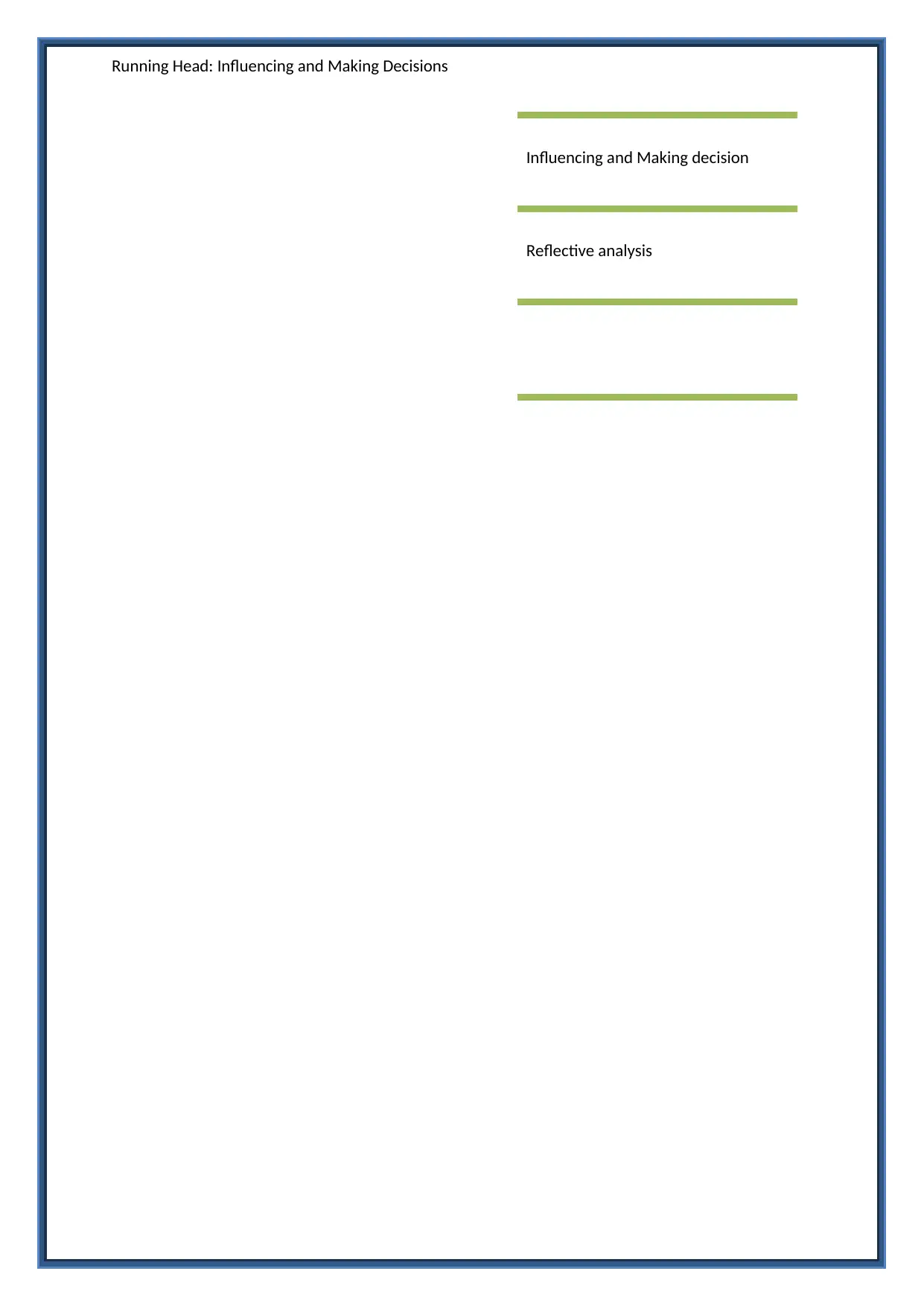
Running Head: Influencing and Making Decisions
Influencing and Making decision
Reflective analysis
Influencing and Making decision
Reflective analysis
Secure Best Marks with AI Grader
Need help grading? Try our AI Grader for instant feedback on your assignments.
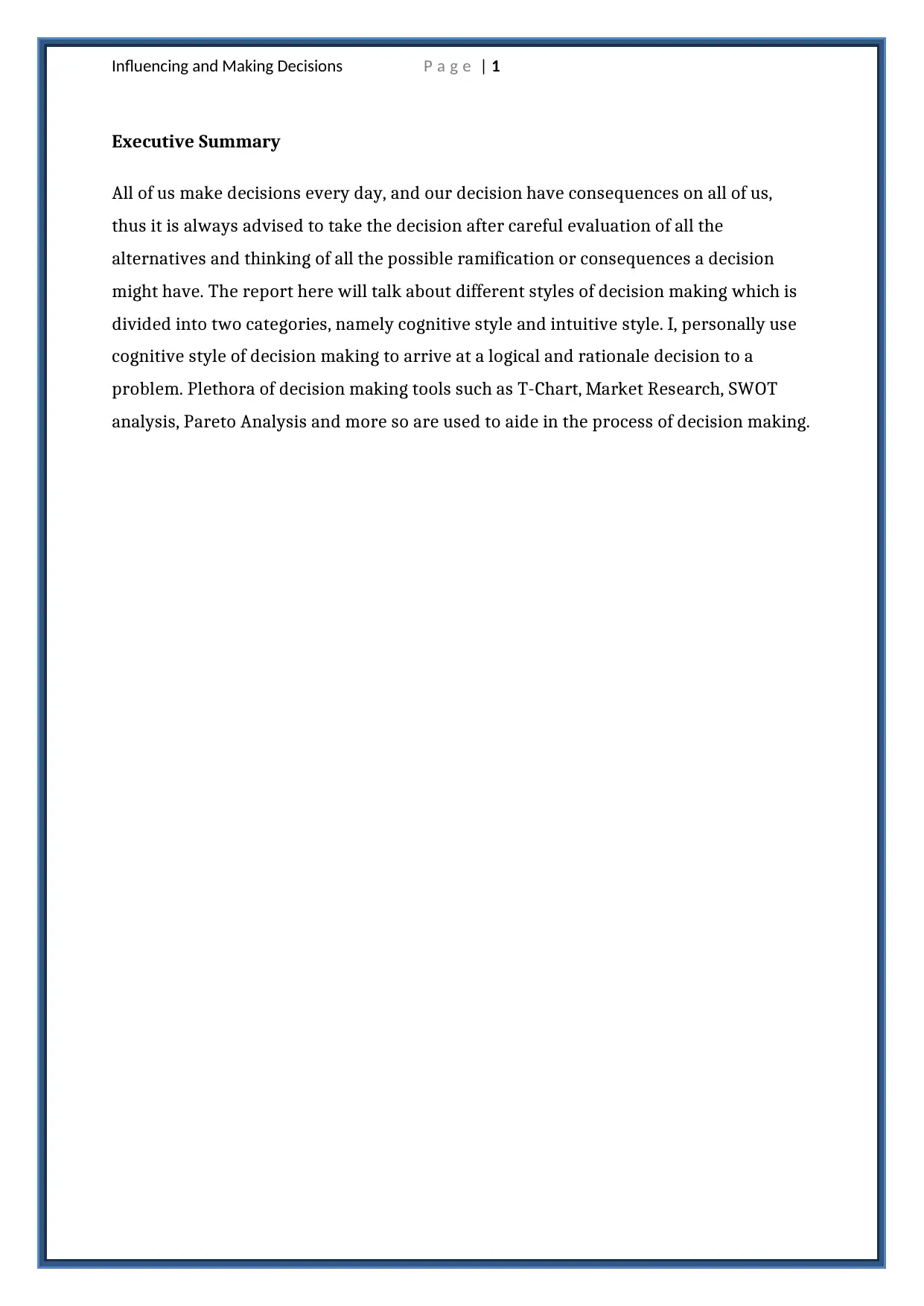
Influencing and Making Decisions P a g e | 1
Executive Summary
All of us make decisions every day, and our decision have consequences on all of us,
thus it is always advised to take the decision after careful evaluation of all the
alternatives and thinking of all the possible ramification or consequences a decision
might have. The report here will talk about different styles of decision making which is
divided into two categories, namely cognitive style and intuitive style. I, personally use
cognitive style of decision making to arrive at a logical and rationale decision to a
problem. Plethora of decision making tools such as T-Chart, Market Research, SWOT
analysis, Pareto Analysis and more so are used to aide in the process of decision making.
Executive Summary
All of us make decisions every day, and our decision have consequences on all of us,
thus it is always advised to take the decision after careful evaluation of all the
alternatives and thinking of all the possible ramification or consequences a decision
might have. The report here will talk about different styles of decision making which is
divided into two categories, namely cognitive style and intuitive style. I, personally use
cognitive style of decision making to arrive at a logical and rationale decision to a
problem. Plethora of decision making tools such as T-Chart, Market Research, SWOT
analysis, Pareto Analysis and more so are used to aide in the process of decision making.
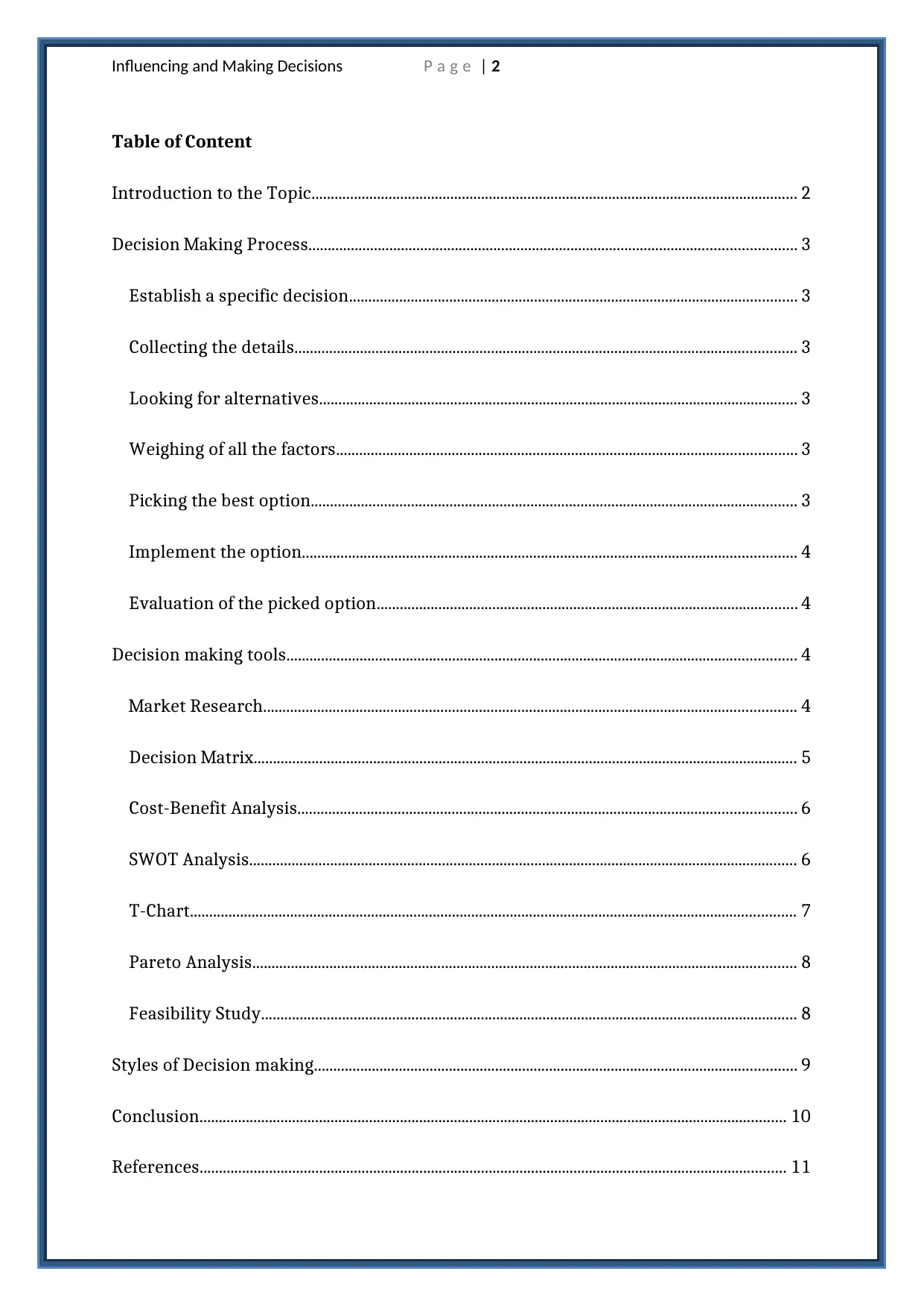
Influencing and Making Decisions P a g e | 2
Table of Content
Introduction to the Topic.............................................................................................................................. 2
Decision Making Process.............................................................................................................................. 3
Establish a specific decision.................................................................................................................... 3
Collecting the details.................................................................................................................................. 3
Looking for alternatives............................................................................................................................ 3
Weighing of all the factors....................................................................................................................... 3
Picking the best option.............................................................................................................................. 3
Implement the option................................................................................................................................ 4
Evaluation of the picked option............................................................................................................. 4
Decision making tools.................................................................................................................................... 4
Market Research.......................................................................................................................................... 4
Decision Matrix............................................................................................................................................. 5
Cost-Benefit Analysis................................................................................................................................. 6
SWOT Analysis.............................................................................................................................................. 6
T-Chart............................................................................................................................................................. 7
Pareto Analysis............................................................................................................................................. 8
Feasibility Study........................................................................................................................................... 8
Styles of Decision making............................................................................................................................. 9
Conclusion........................................................................................................................................................ 10
References........................................................................................................................................................ 11
Table of Content
Introduction to the Topic.............................................................................................................................. 2
Decision Making Process.............................................................................................................................. 3
Establish a specific decision.................................................................................................................... 3
Collecting the details.................................................................................................................................. 3
Looking for alternatives............................................................................................................................ 3
Weighing of all the factors....................................................................................................................... 3
Picking the best option.............................................................................................................................. 3
Implement the option................................................................................................................................ 4
Evaluation of the picked option............................................................................................................. 4
Decision making tools.................................................................................................................................... 4
Market Research.......................................................................................................................................... 4
Decision Matrix............................................................................................................................................. 5
Cost-Benefit Analysis................................................................................................................................. 6
SWOT Analysis.............................................................................................................................................. 6
T-Chart............................................................................................................................................................. 7
Pareto Analysis............................................................................................................................................. 8
Feasibility Study........................................................................................................................................... 8
Styles of Decision making............................................................................................................................. 9
Conclusion........................................................................................................................................................ 10
References........................................................................................................................................................ 11
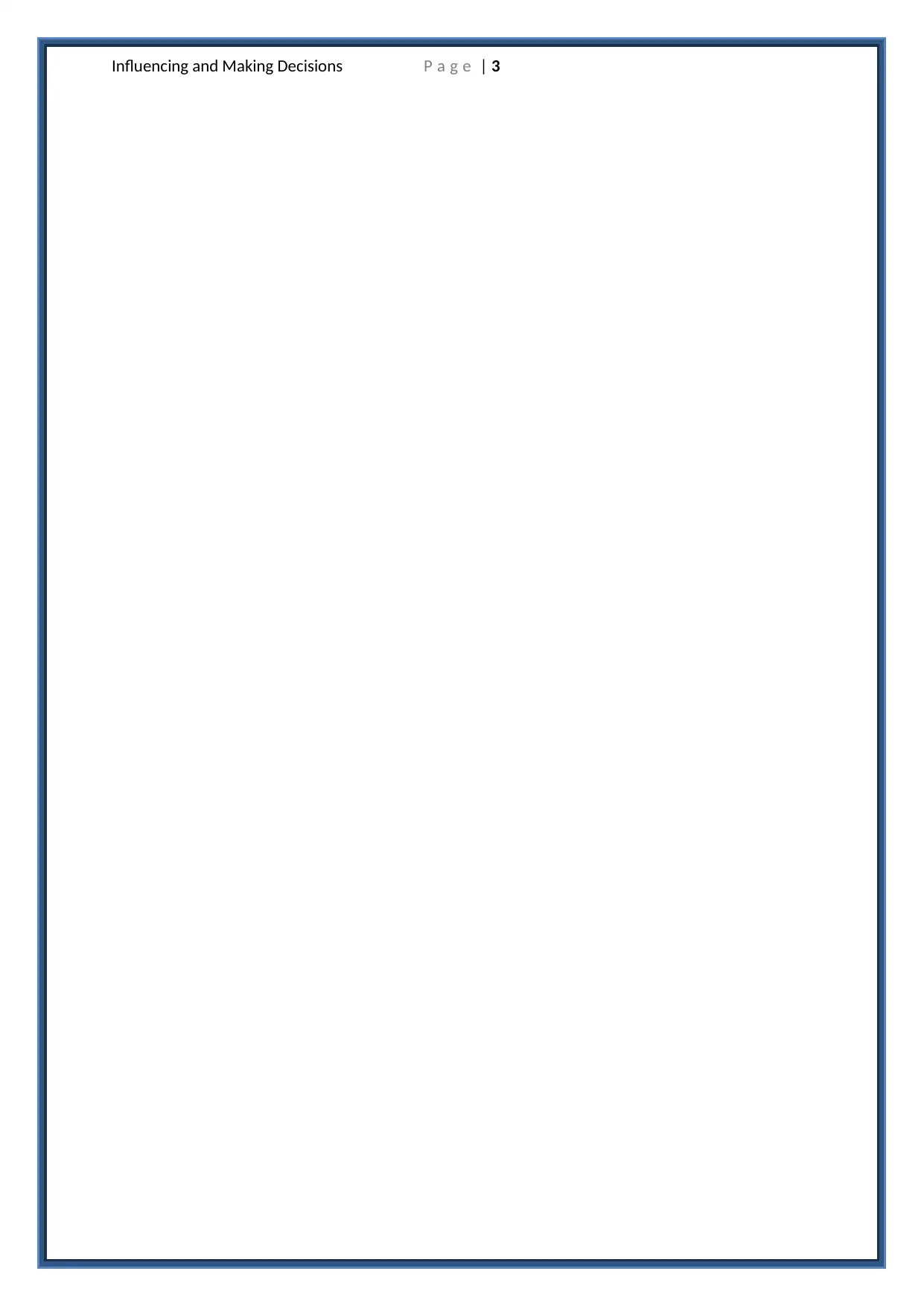
Influencing and Making Decisions P a g e | 3
Secure Best Marks with AI Grader
Need help grading? Try our AI Grader for instant feedback on your assignments.
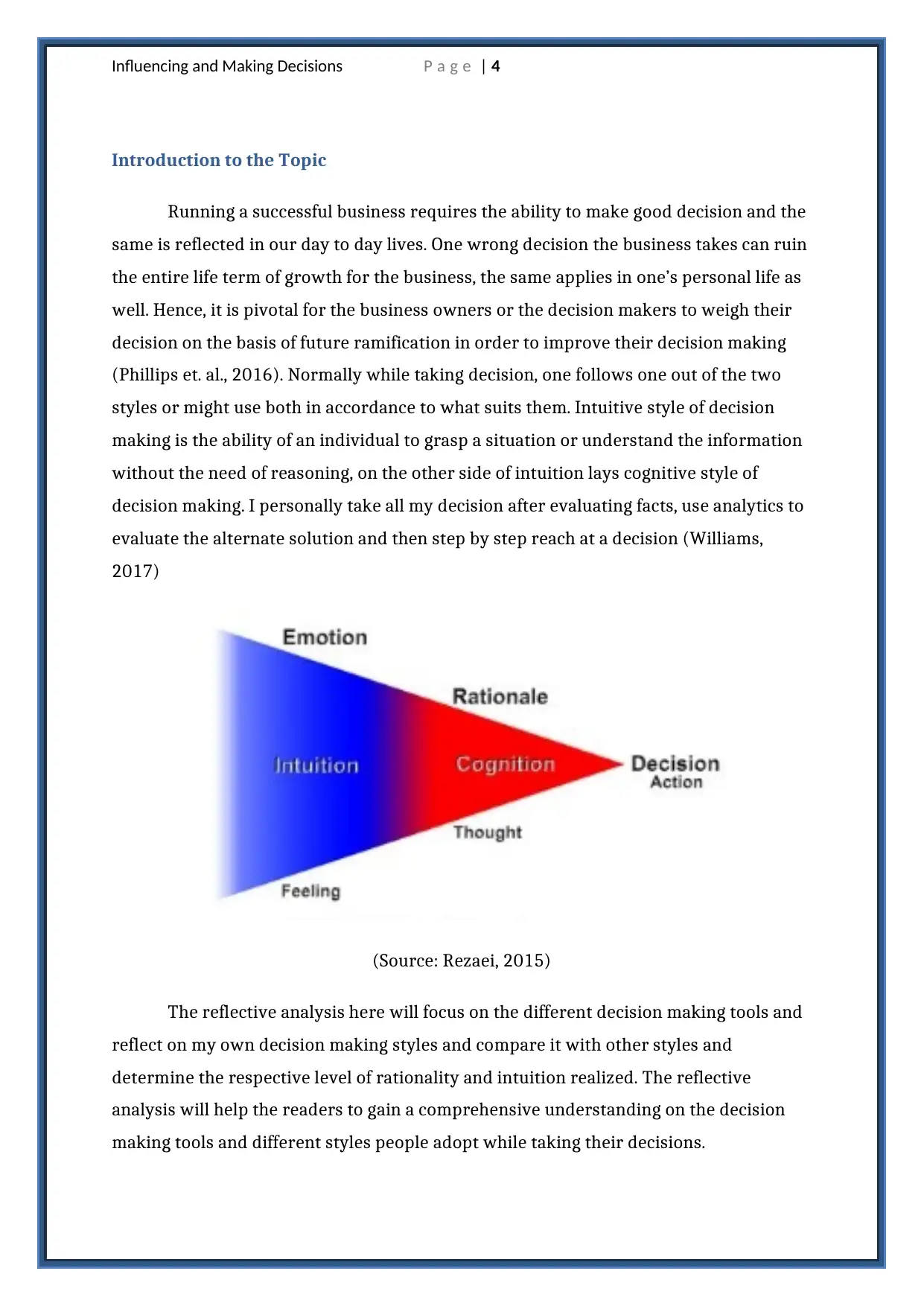
Influencing and Making Decisions P a g e | 4
Introduction to the Topic
Running a successful business requires the ability to make good decision and the
same is reflected in our day to day lives. One wrong decision the business takes can ruin
the entire life term of growth for the business, the same applies in one’s personal life as
well. Hence, it is pivotal for the business owners or the decision makers to weigh their
decision on the basis of future ramification in order to improve their decision making
(Phillips et. al., 2016). Normally while taking decision, one follows one out of the two
styles or might use both in accordance to what suits them. Intuitive style of decision
making is the ability of an individual to grasp a situation or understand the information
without the need of reasoning, on the other side of intuition lays cognitive style of
decision making. I personally take all my decision after evaluating facts, use analytics to
evaluate the alternate solution and then step by step reach at a decision (Williams,
2017)
(Source: Rezaei, 2015)
The reflective analysis here will focus on the different decision making tools and
reflect on my own decision making styles and compare it with other styles and
determine the respective level of rationality and intuition realized. The reflective
analysis will help the readers to gain a comprehensive understanding on the decision
making tools and different styles people adopt while taking their decisions.
Introduction to the Topic
Running a successful business requires the ability to make good decision and the
same is reflected in our day to day lives. One wrong decision the business takes can ruin
the entire life term of growth for the business, the same applies in one’s personal life as
well. Hence, it is pivotal for the business owners or the decision makers to weigh their
decision on the basis of future ramification in order to improve their decision making
(Phillips et. al., 2016). Normally while taking decision, one follows one out of the two
styles or might use both in accordance to what suits them. Intuitive style of decision
making is the ability of an individual to grasp a situation or understand the information
without the need of reasoning, on the other side of intuition lays cognitive style of
decision making. I personally take all my decision after evaluating facts, use analytics to
evaluate the alternate solution and then step by step reach at a decision (Williams,
2017)
(Source: Rezaei, 2015)
The reflective analysis here will focus on the different decision making tools and
reflect on my own decision making styles and compare it with other styles and
determine the respective level of rationality and intuition realized. The reflective
analysis will help the readers to gain a comprehensive understanding on the decision
making tools and different styles people adopt while taking their decisions.
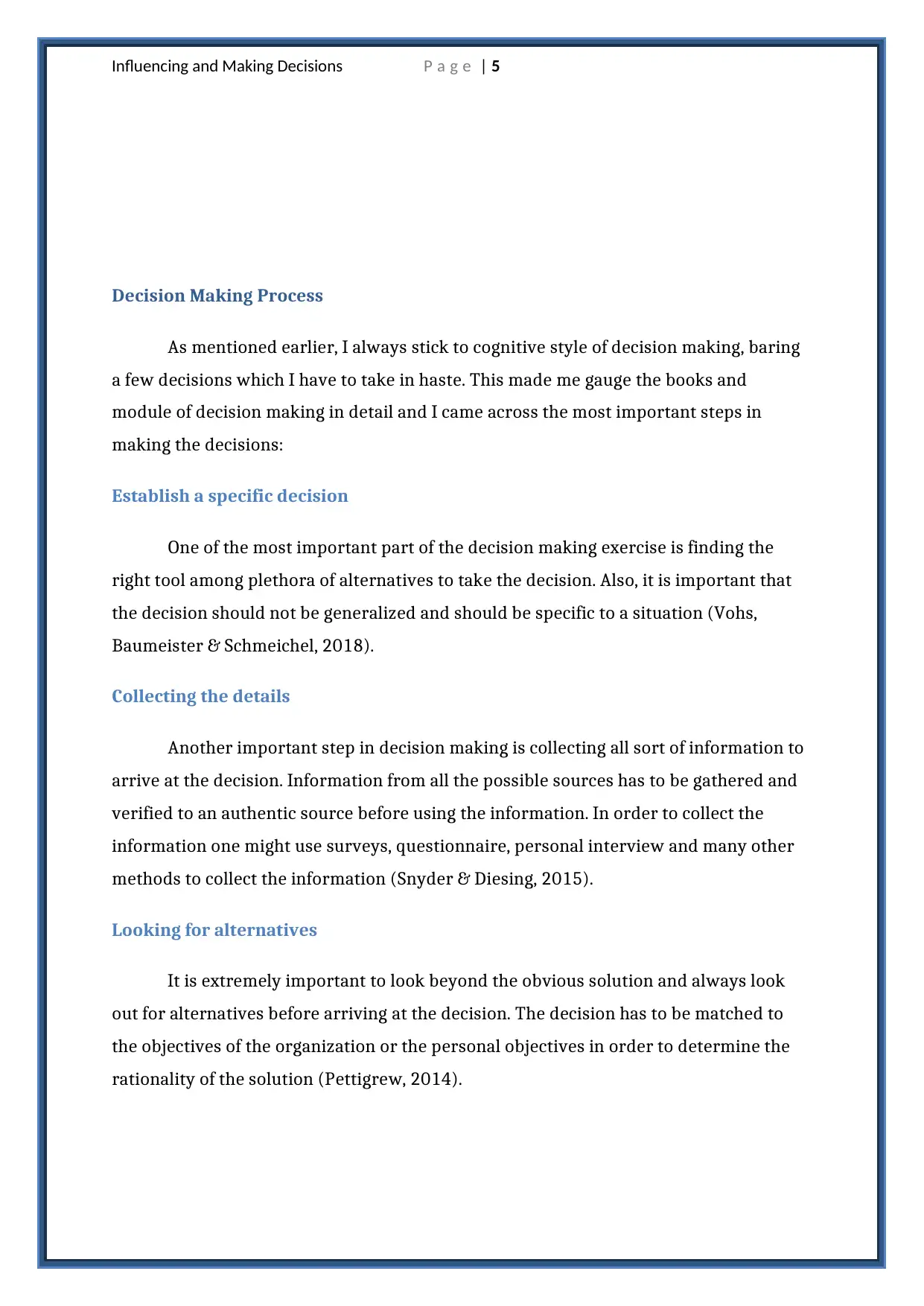
Influencing and Making Decisions P a g e | 5
Decision Making Process
As mentioned earlier, I always stick to cognitive style of decision making, baring
a few decisions which I have to take in haste. This made me gauge the books and
module of decision making in detail and I came across the most important steps in
making the decisions:
Establish a specific decision
One of the most important part of the decision making exercise is finding the
right tool among plethora of alternatives to take the decision. Also, it is important that
the decision should not be generalized and should be specific to a situation (Vohs,
Baumeister & Schmeichel, 2018).
Collecting the details
Another important step in decision making is collecting all sort of information to
arrive at the decision. Information from all the possible sources has to be gathered and
verified to an authentic source before using the information. In order to collect the
information one might use surveys, questionnaire, personal interview and many other
methods to collect the information (Snyder & Diesing, 2015).
Looking for alternatives
It is extremely important to look beyond the obvious solution and always look
out for alternatives before arriving at the decision. The decision has to be matched to
the objectives of the organization or the personal objectives in order to determine the
rationality of the solution (Pettigrew, 2014).
Decision Making Process
As mentioned earlier, I always stick to cognitive style of decision making, baring
a few decisions which I have to take in haste. This made me gauge the books and
module of decision making in detail and I came across the most important steps in
making the decisions:
Establish a specific decision
One of the most important part of the decision making exercise is finding the
right tool among plethora of alternatives to take the decision. Also, it is important that
the decision should not be generalized and should be specific to a situation (Vohs,
Baumeister & Schmeichel, 2018).
Collecting the details
Another important step in decision making is collecting all sort of information to
arrive at the decision. Information from all the possible sources has to be gathered and
verified to an authentic source before using the information. In order to collect the
information one might use surveys, questionnaire, personal interview and many other
methods to collect the information (Snyder & Diesing, 2015).
Looking for alternatives
It is extremely important to look beyond the obvious solution and always look
out for alternatives before arriving at the decision. The decision has to be matched to
the objectives of the organization or the personal objectives in order to determine the
rationality of the solution (Pettigrew, 2014).
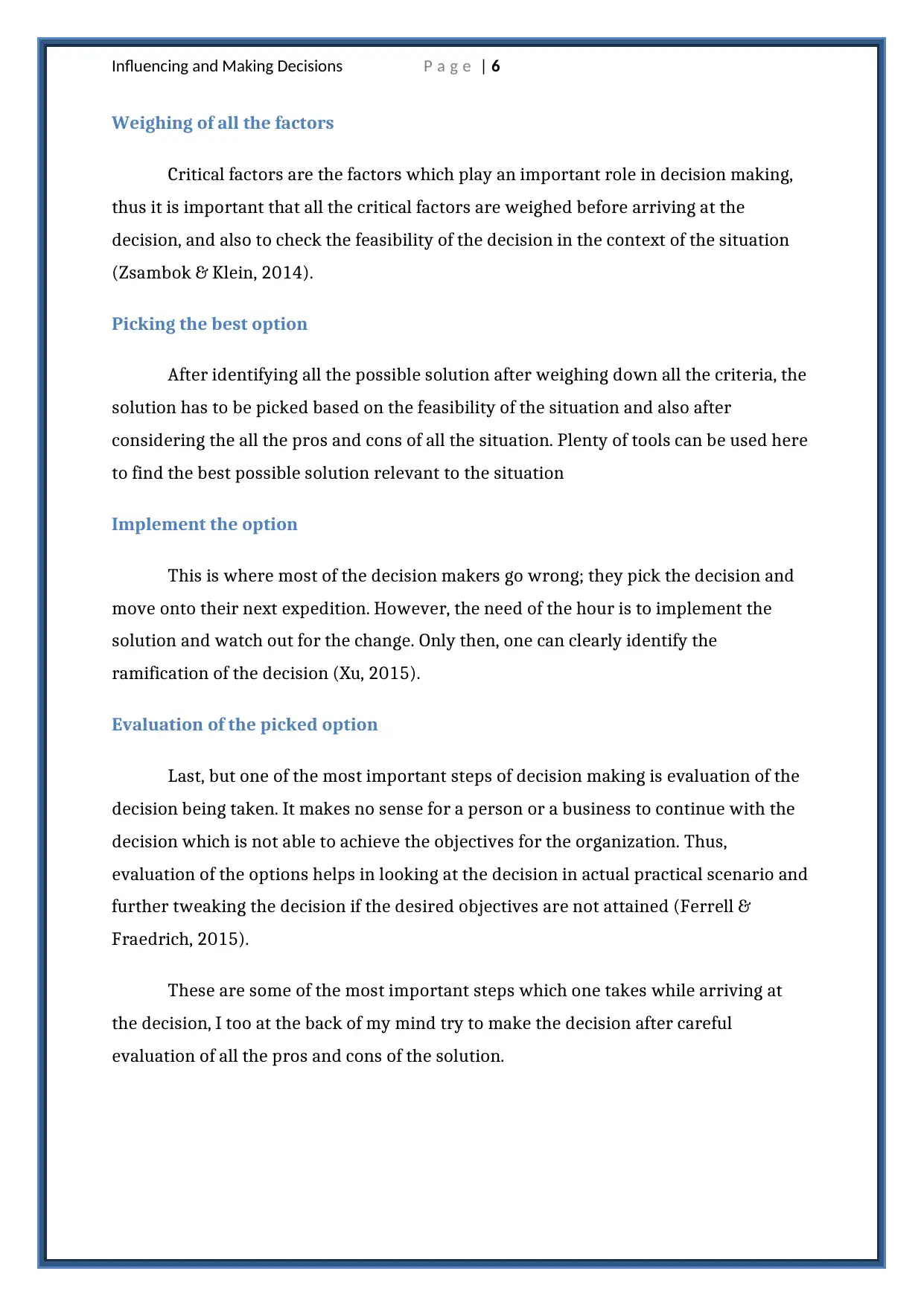
Influencing and Making Decisions P a g e | 6
Weighing of all the factors
Critical factors are the factors which play an important role in decision making,
thus it is important that all the critical factors are weighed before arriving at the
decision, and also to check the feasibility of the decision in the context of the situation
(Zsambok & Klein, 2014).
Picking the best option
After identifying all the possible solution after weighing down all the criteria, the
solution has to be picked based on the feasibility of the situation and also after
considering the all the pros and cons of all the situation. Plenty of tools can be used here
to find the best possible solution relevant to the situation
Implement the option
This is where most of the decision makers go wrong; they pick the decision and
move onto their next expedition. However, the need of the hour is to implement the
solution and watch out for the change. Only then, one can clearly identify the
ramification of the decision (Xu, 2015).
Evaluation of the picked option
Last, but one of the most important steps of decision making is evaluation of the
decision being taken. It makes no sense for a person or a business to continue with the
decision which is not able to achieve the objectives for the organization. Thus,
evaluation of the options helps in looking at the decision in actual practical scenario and
further tweaking the decision if the desired objectives are not attained (Ferrell &
Fraedrich, 2015).
These are some of the most important steps which one takes while arriving at
the decision, I too at the back of my mind try to make the decision after careful
evaluation of all the pros and cons of the solution.
Weighing of all the factors
Critical factors are the factors which play an important role in decision making,
thus it is important that all the critical factors are weighed before arriving at the
decision, and also to check the feasibility of the decision in the context of the situation
(Zsambok & Klein, 2014).
Picking the best option
After identifying all the possible solution after weighing down all the criteria, the
solution has to be picked based on the feasibility of the situation and also after
considering the all the pros and cons of all the situation. Plenty of tools can be used here
to find the best possible solution relevant to the situation
Implement the option
This is where most of the decision makers go wrong; they pick the decision and
move onto their next expedition. However, the need of the hour is to implement the
solution and watch out for the change. Only then, one can clearly identify the
ramification of the decision (Xu, 2015).
Evaluation of the picked option
Last, but one of the most important steps of decision making is evaluation of the
decision being taken. It makes no sense for a person or a business to continue with the
decision which is not able to achieve the objectives for the organization. Thus,
evaluation of the options helps in looking at the decision in actual practical scenario and
further tweaking the decision if the desired objectives are not attained (Ferrell &
Fraedrich, 2015).
These are some of the most important steps which one takes while arriving at
the decision, I too at the back of my mind try to make the decision after careful
evaluation of all the pros and cons of the solution.
Paraphrase This Document
Need a fresh take? Get an instant paraphrase of this document with our AI Paraphraser
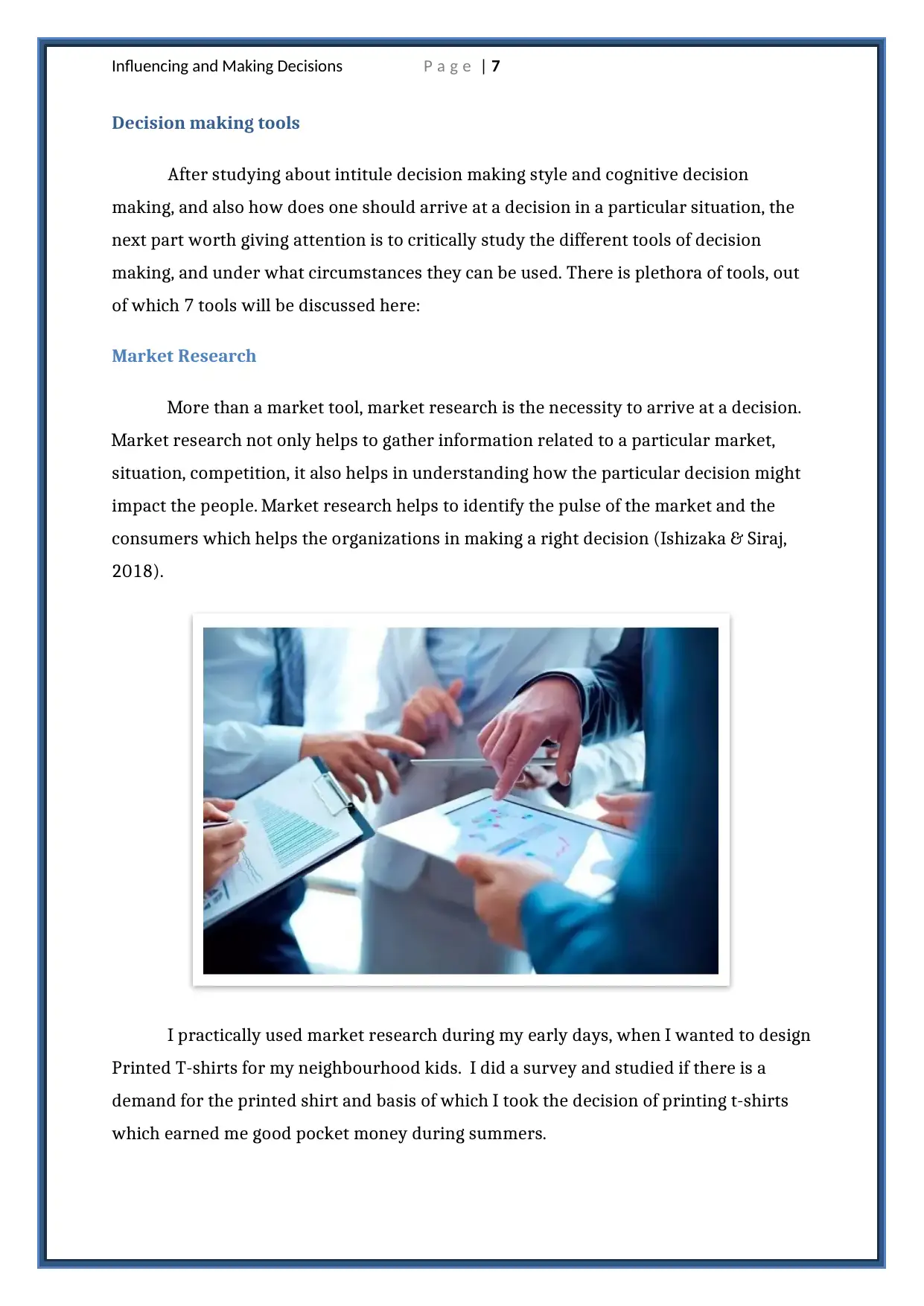
Influencing and Making Decisions P a g e | 7
Decision making tools
After studying about intitule decision making style and cognitive decision
making, and also how does one should arrive at a decision in a particular situation, the
next part worth giving attention is to critically study the different tools of decision
making, and under what circumstances they can be used. There is plethora of tools, out
of which 7 tools will be discussed here:
Market Research
More than a market tool, market research is the necessity to arrive at a decision.
Market research not only helps to gather information related to a particular market,
situation, competition, it also helps in understanding how the particular decision might
impact the people. Market research helps to identify the pulse of the market and the
consumers which helps the organizations in making a right decision (Ishizaka & Siraj,
2018).
I practically used market research during my early days, when I wanted to design
Printed T-shirts for my neighbourhood kids. I did a survey and studied if there is a
demand for the printed shirt and basis of which I took the decision of printing t-shirts
which earned me good pocket money during summers.
Decision making tools
After studying about intitule decision making style and cognitive decision
making, and also how does one should arrive at a decision in a particular situation, the
next part worth giving attention is to critically study the different tools of decision
making, and under what circumstances they can be used. There is plethora of tools, out
of which 7 tools will be discussed here:
Market Research
More than a market tool, market research is the necessity to arrive at a decision.
Market research not only helps to gather information related to a particular market,
situation, competition, it also helps in understanding how the particular decision might
impact the people. Market research helps to identify the pulse of the market and the
consumers which helps the organizations in making a right decision (Ishizaka & Siraj,
2018).
I practically used market research during my early days, when I wanted to design
Printed T-shirts for my neighbourhood kids. I did a survey and studied if there is a
demand for the printed shirt and basis of which I took the decision of printing t-shirts
which earned me good pocket money during summers.
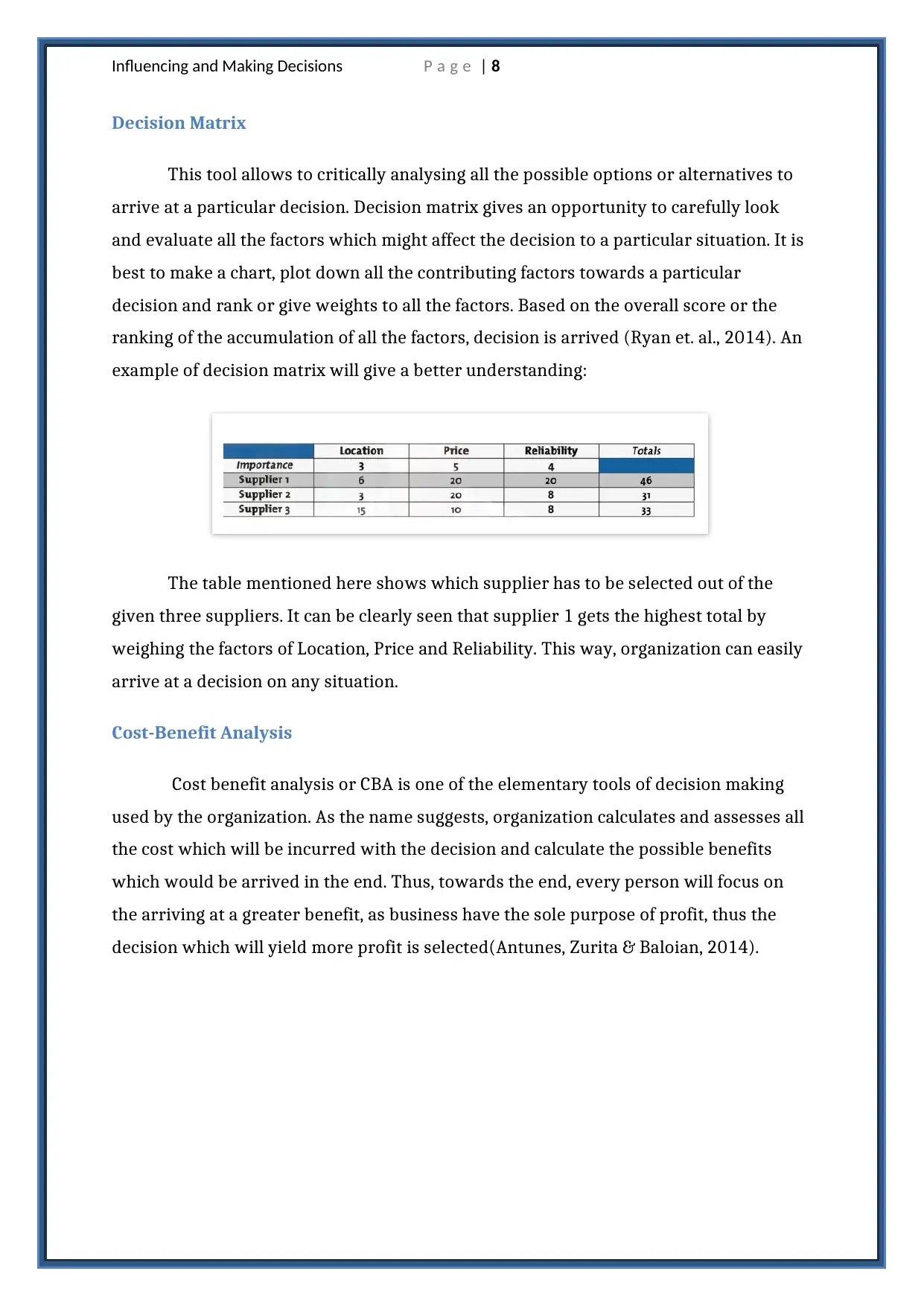
Influencing and Making Decisions P a g e | 8
Decision Matrix
This tool allows to critically analysing all the possible options or alternatives to
arrive at a particular decision. Decision matrix gives an opportunity to carefully look
and evaluate all the factors which might affect the decision to a particular situation. It is
best to make a chart, plot down all the contributing factors towards a particular
decision and rank or give weights to all the factors. Based on the overall score or the
ranking of the accumulation of all the factors, decision is arrived (Ryan et. al., 2014). An
example of decision matrix will give a better understanding:
The table mentioned here shows which supplier has to be selected out of the
given three suppliers. It can be clearly seen that supplier 1 gets the highest total by
weighing the factors of Location, Price and Reliability. This way, organization can easily
arrive at a decision on any situation.
Cost-Benefit Analysis
Cost benefit analysis or CBA is one of the elementary tools of decision making
used by the organization. As the name suggests, organization calculates and assesses all
the cost which will be incurred with the decision and calculate the possible benefits
which would be arrived in the end. Thus, towards the end, every person will focus on
the arriving at a greater benefit, as business have the sole purpose of profit, thus the
decision which will yield more profit is selected(Antunes, Zurita & Baloian, 2014).
Decision Matrix
This tool allows to critically analysing all the possible options or alternatives to
arrive at a particular decision. Decision matrix gives an opportunity to carefully look
and evaluate all the factors which might affect the decision to a particular situation. It is
best to make a chart, plot down all the contributing factors towards a particular
decision and rank or give weights to all the factors. Based on the overall score or the
ranking of the accumulation of all the factors, decision is arrived (Ryan et. al., 2014). An
example of decision matrix will give a better understanding:
The table mentioned here shows which supplier has to be selected out of the
given three suppliers. It can be clearly seen that supplier 1 gets the highest total by
weighing the factors of Location, Price and Reliability. This way, organization can easily
arrive at a decision on any situation.
Cost-Benefit Analysis
Cost benefit analysis or CBA is one of the elementary tools of decision making
used by the organization. As the name suggests, organization calculates and assesses all
the cost which will be incurred with the decision and calculate the possible benefits
which would be arrived in the end. Thus, towards the end, every person will focus on
the arriving at a greater benefit, as business have the sole purpose of profit, thus the
decision which will yield more profit is selected(Antunes, Zurita & Baloian, 2014).
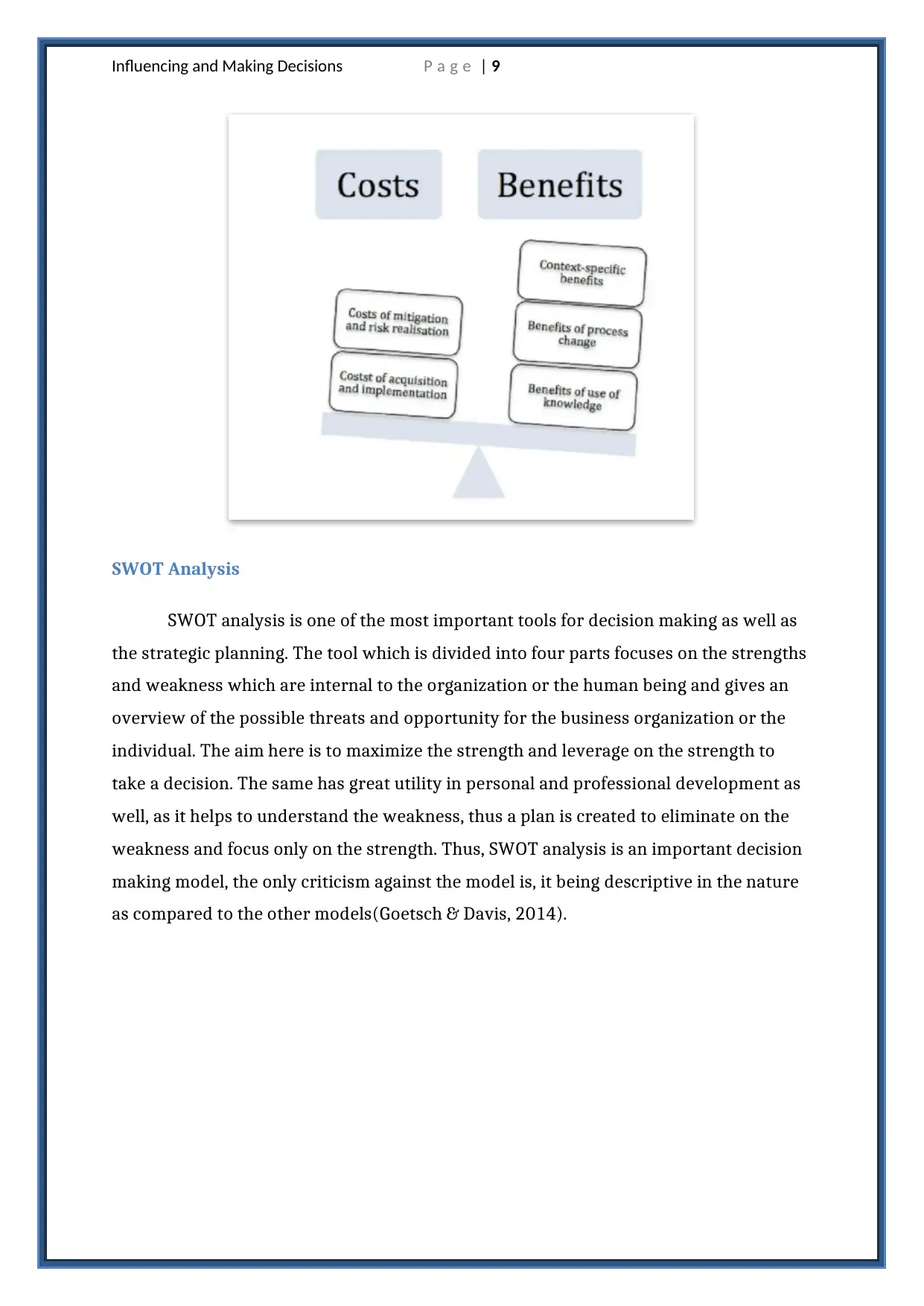
Influencing and Making Decisions P a g e | 9
SWOT Analysis
SWOT analysis is one of the most important tools for decision making as well as
the strategic planning. The tool which is divided into four parts focuses on the strengths
and weakness which are internal to the organization or the human being and gives an
overview of the possible threats and opportunity for the business organization or the
individual. The aim here is to maximize the strength and leverage on the strength to
take a decision. The same has great utility in personal and professional development as
well, as it helps to understand the weakness, thus a plan is created to eliminate on the
weakness and focus only on the strength. Thus, SWOT analysis is an important decision
making model, the only criticism against the model is, it being descriptive in the nature
as compared to the other models(Goetsch & Davis, 2014).
SWOT Analysis
SWOT analysis is one of the most important tools for decision making as well as
the strategic planning. The tool which is divided into four parts focuses on the strengths
and weakness which are internal to the organization or the human being and gives an
overview of the possible threats and opportunity for the business organization or the
individual. The aim here is to maximize the strength and leverage on the strength to
take a decision. The same has great utility in personal and professional development as
well, as it helps to understand the weakness, thus a plan is created to eliminate on the
weakness and focus only on the strength. Thus, SWOT analysis is an important decision
making model, the only criticism against the model is, it being descriptive in the nature
as compared to the other models(Goetsch & Davis, 2014).
Secure Best Marks with AI Grader
Need help grading? Try our AI Grader for instant feedback on your assignments.
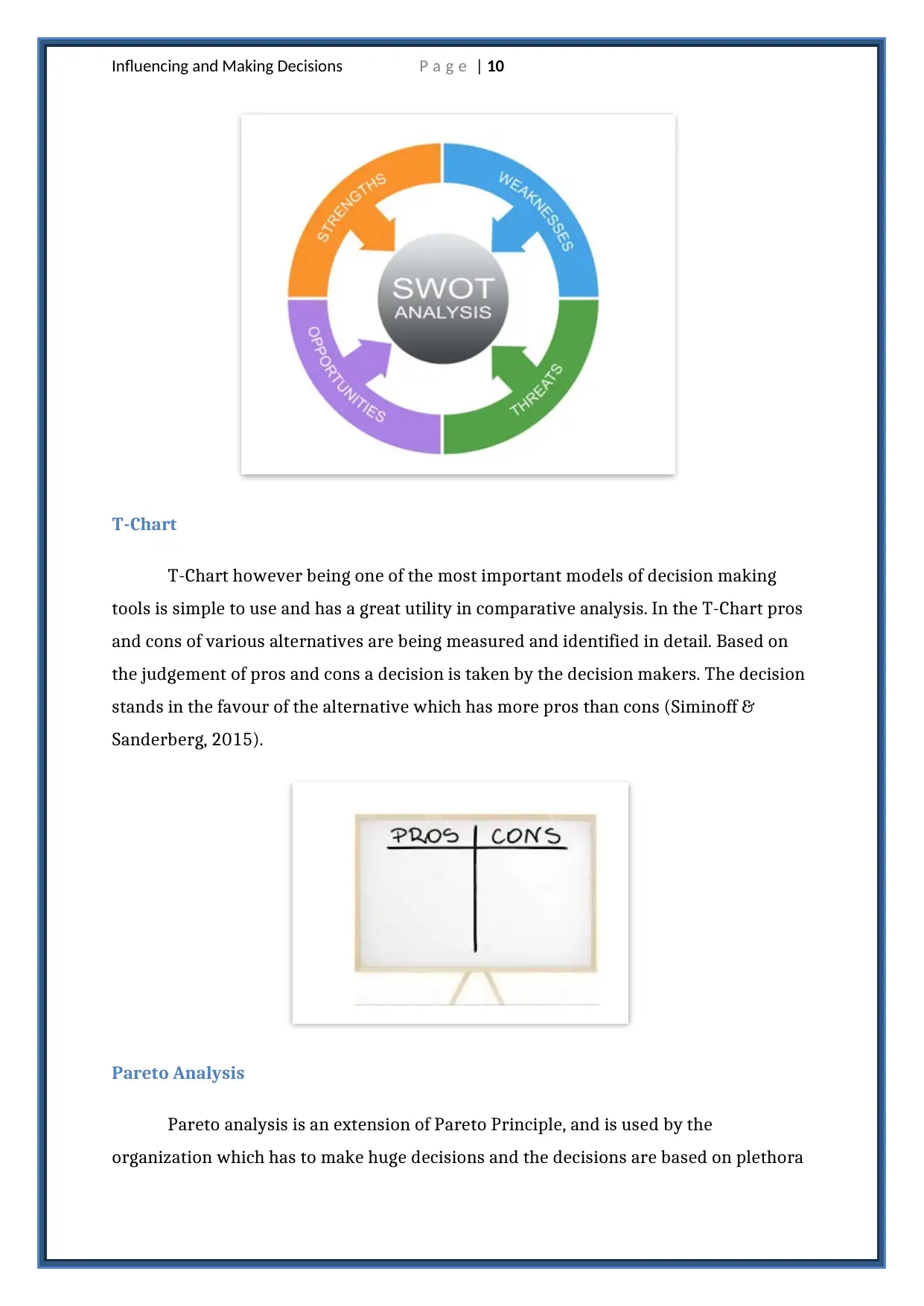
Influencing and Making Decisions P a g e | 10
T-Chart
T-Chart however being one of the most important models of decision making
tools is simple to use and has a great utility in comparative analysis. In the T-Chart pros
and cons of various alternatives are being measured and identified in detail. Based on
the judgement of pros and cons a decision is taken by the decision makers. The decision
stands in the favour of the alternative which has more pros than cons (Siminoff &
Sanderberg, 2015).
Pareto Analysis
Pareto analysis is an extension of Pareto Principle, and is used by the
organization which has to make huge decisions and the decisions are based on plethora
T-Chart
T-Chart however being one of the most important models of decision making
tools is simple to use and has a great utility in comparative analysis. In the T-Chart pros
and cons of various alternatives are being measured and identified in detail. Based on
the judgement of pros and cons a decision is taken by the decision makers. The decision
stands in the favour of the alternative which has more pros than cons (Siminoff &
Sanderberg, 2015).
Pareto Analysis
Pareto analysis is an extension of Pareto Principle, and is used by the
organization which has to make huge decisions and the decisions are based on plethora
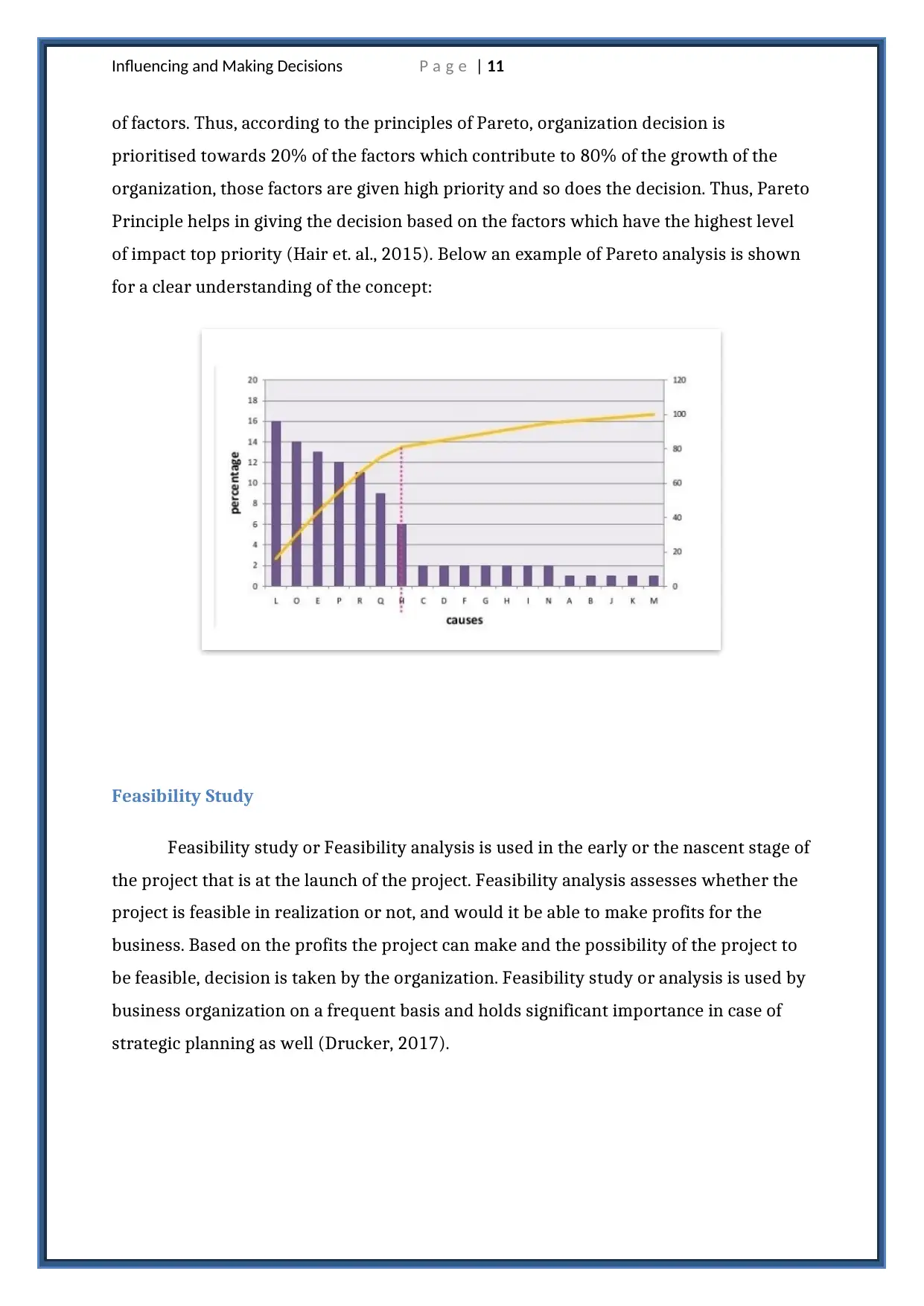
Influencing and Making Decisions P a g e | 11
of factors. Thus, according to the principles of Pareto, organization decision is
prioritised towards 20% of the factors which contribute to 80% of the growth of the
organization, those factors are given high priority and so does the decision. Thus, Pareto
Principle helps in giving the decision based on the factors which have the highest level
of impact top priority (Hair et. al., 2015). Below an example of Pareto analysis is shown
for a clear understanding of the concept:
Feasibility Study
Feasibility study or Feasibility analysis is used in the early or the nascent stage of
the project that is at the launch of the project. Feasibility analysis assesses whether the
project is feasible in realization or not, and would it be able to make profits for the
business. Based on the profits the project can make and the possibility of the project to
be feasible, decision is taken by the organization. Feasibility study or analysis is used by
business organization on a frequent basis and holds significant importance in case of
strategic planning as well (Drucker, 2017).
of factors. Thus, according to the principles of Pareto, organization decision is
prioritised towards 20% of the factors which contribute to 80% of the growth of the
organization, those factors are given high priority and so does the decision. Thus, Pareto
Principle helps in giving the decision based on the factors which have the highest level
of impact top priority (Hair et. al., 2015). Below an example of Pareto analysis is shown
for a clear understanding of the concept:
Feasibility Study
Feasibility study or Feasibility analysis is used in the early or the nascent stage of
the project that is at the launch of the project. Feasibility analysis assesses whether the
project is feasible in realization or not, and would it be able to make profits for the
business. Based on the profits the project can make and the possibility of the project to
be feasible, decision is taken by the organization. Feasibility study or analysis is used by
business organization on a frequent basis and holds significant importance in case of
strategic planning as well (Drucker, 2017).
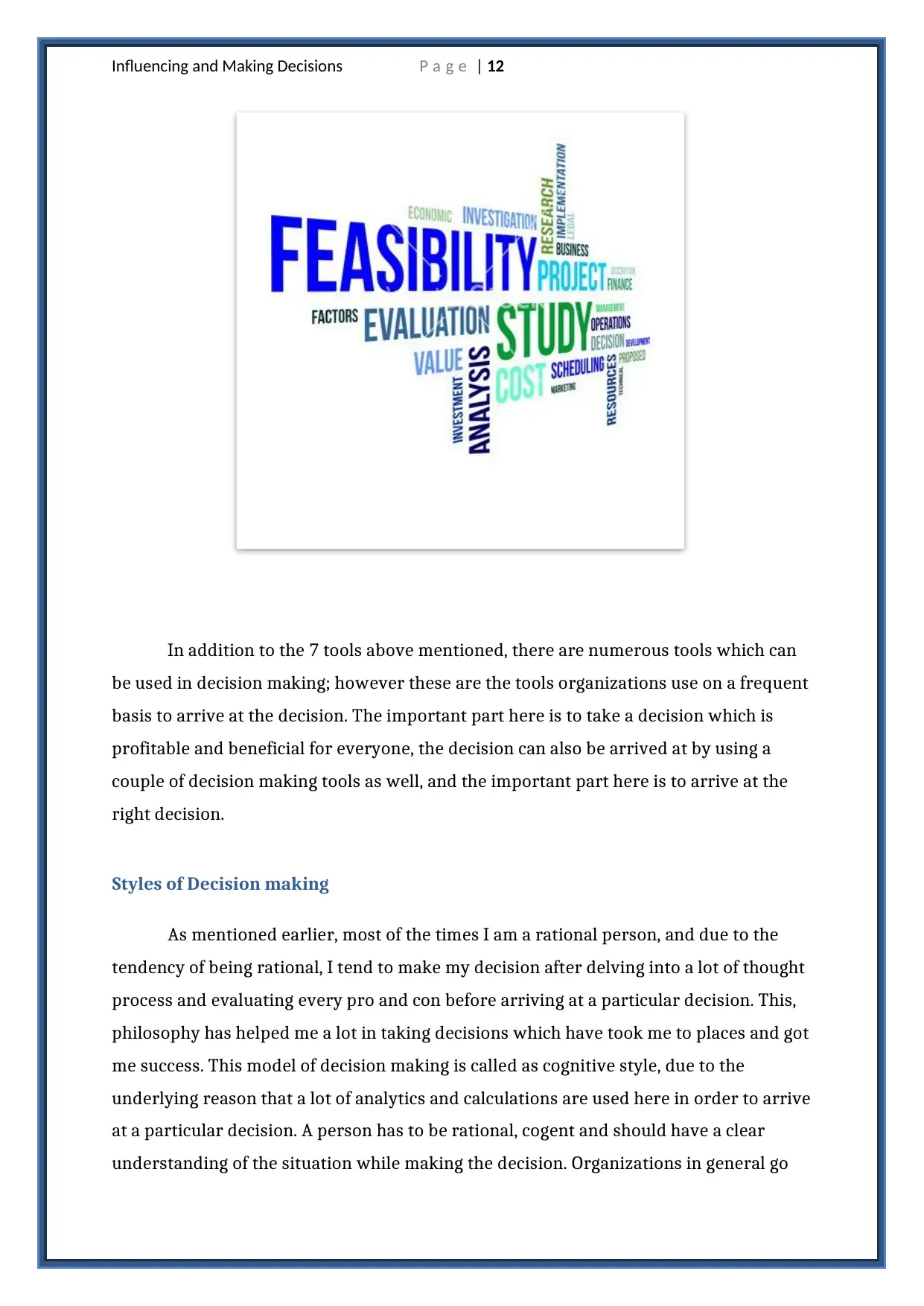
Influencing and Making Decisions P a g e | 12
In addition to the 7 tools above mentioned, there are numerous tools which can
be used in decision making; however these are the tools organizations use on a frequent
basis to arrive at the decision. The important part here is to take a decision which is
profitable and beneficial for everyone, the decision can also be arrived at by using a
couple of decision making tools as well, and the important part here is to arrive at the
right decision.
Styles of Decision making
As mentioned earlier, most of the times I am a rational person, and due to the
tendency of being rational, I tend to make my decision after delving into a lot of thought
process and evaluating every pro and con before arriving at a particular decision. This,
philosophy has helped me a lot in taking decisions which have took me to places and got
me success. This model of decision making is called as cognitive style, due to the
underlying reason that a lot of analytics and calculations are used here in order to arrive
at a particular decision. A person has to be rational, cogent and should have a clear
understanding of the situation while making the decision. Organizations in general go
In addition to the 7 tools above mentioned, there are numerous tools which can
be used in decision making; however these are the tools organizations use on a frequent
basis to arrive at the decision. The important part here is to take a decision which is
profitable and beneficial for everyone, the decision can also be arrived at by using a
couple of decision making tools as well, and the important part here is to arrive at the
right decision.
Styles of Decision making
As mentioned earlier, most of the times I am a rational person, and due to the
tendency of being rational, I tend to make my decision after delving into a lot of thought
process and evaluating every pro and con before arriving at a particular decision. This,
philosophy has helped me a lot in taking decisions which have took me to places and got
me success. This model of decision making is called as cognitive style, due to the
underlying reason that a lot of analytics and calculations are used here in order to arrive
at a particular decision. A person has to be rational, cogent and should have a clear
understanding of the situation while making the decision. Organizations in general go
Paraphrase This Document
Need a fresh take? Get an instant paraphrase of this document with our AI Paraphraser
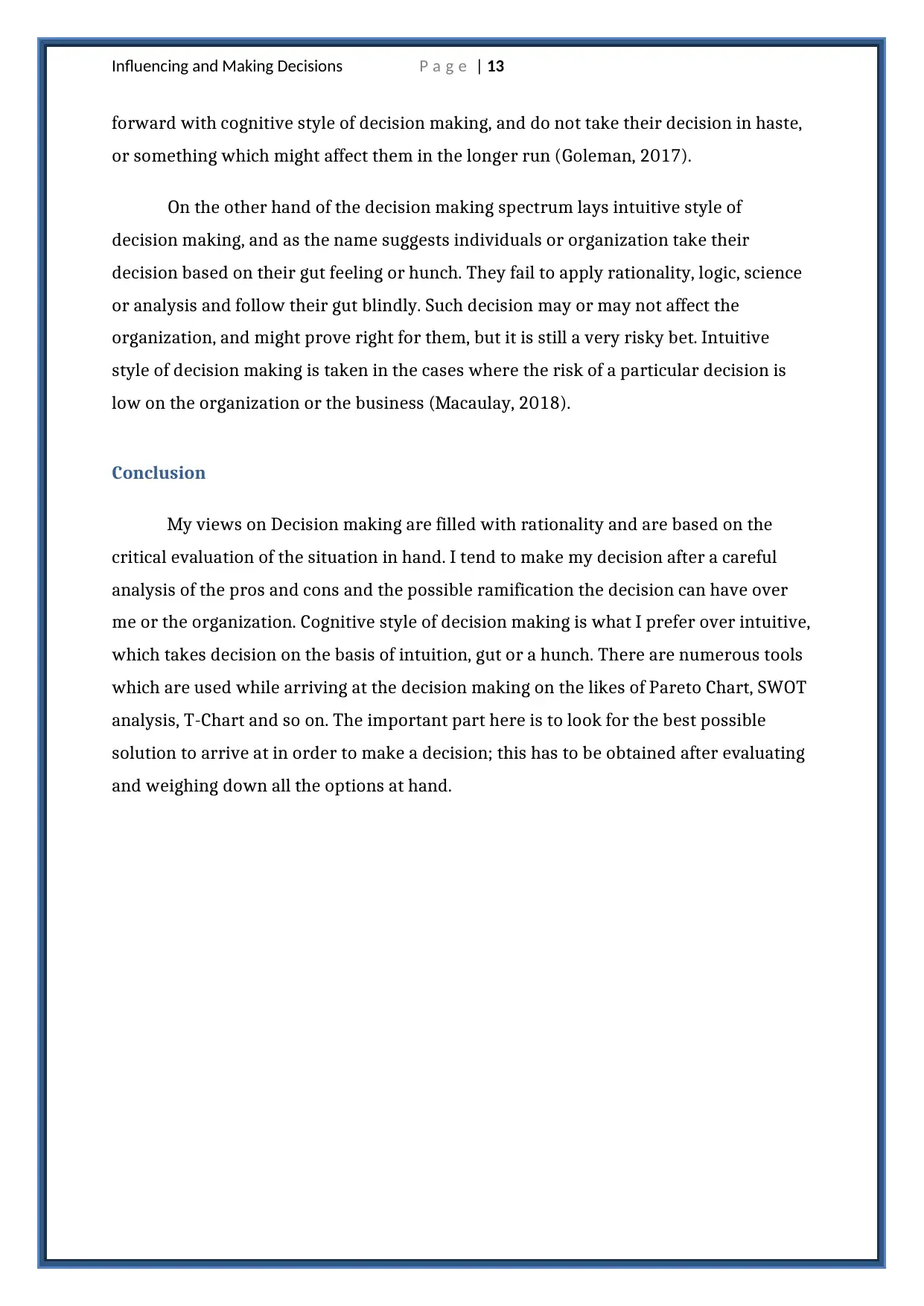
Influencing and Making Decisions P a g e | 13
forward with cognitive style of decision making, and do not take their decision in haste,
or something which might affect them in the longer run (Goleman, 2017).
On the other hand of the decision making spectrum lays intuitive style of
decision making, and as the name suggests individuals or organization take their
decision based on their gut feeling or hunch. They fail to apply rationality, logic, science
or analysis and follow their gut blindly. Such decision may or may not affect the
organization, and might prove right for them, but it is still a very risky bet. Intuitive
style of decision making is taken in the cases where the risk of a particular decision is
low on the organization or the business (Macaulay, 2018).
Conclusion
My views on Decision making are filled with rationality and are based on the
critical evaluation of the situation in hand. I tend to make my decision after a careful
analysis of the pros and cons and the possible ramification the decision can have over
me or the organization. Cognitive style of decision making is what I prefer over intuitive,
which takes decision on the basis of intuition, gut or a hunch. There are numerous tools
which are used while arriving at the decision making on the likes of Pareto Chart, SWOT
analysis, T-Chart and so on. The important part here is to look for the best possible
solution to arrive at in order to make a decision; this has to be obtained after evaluating
and weighing down all the options at hand.
forward with cognitive style of decision making, and do not take their decision in haste,
or something which might affect them in the longer run (Goleman, 2017).
On the other hand of the decision making spectrum lays intuitive style of
decision making, and as the name suggests individuals or organization take their
decision based on their gut feeling or hunch. They fail to apply rationality, logic, science
or analysis and follow their gut blindly. Such decision may or may not affect the
organization, and might prove right for them, but it is still a very risky bet. Intuitive
style of decision making is taken in the cases where the risk of a particular decision is
low on the organization or the business (Macaulay, 2018).
Conclusion
My views on Decision making are filled with rationality and are based on the
critical evaluation of the situation in hand. I tend to make my decision after a careful
analysis of the pros and cons and the possible ramification the decision can have over
me or the organization. Cognitive style of decision making is what I prefer over intuitive,
which takes decision on the basis of intuition, gut or a hunch. There are numerous tools
which are used while arriving at the decision making on the likes of Pareto Chart, SWOT
analysis, T-Chart and so on. The important part here is to look for the best possible
solution to arrive at in order to make a decision; this has to be obtained after evaluating
and weighing down all the options at hand.
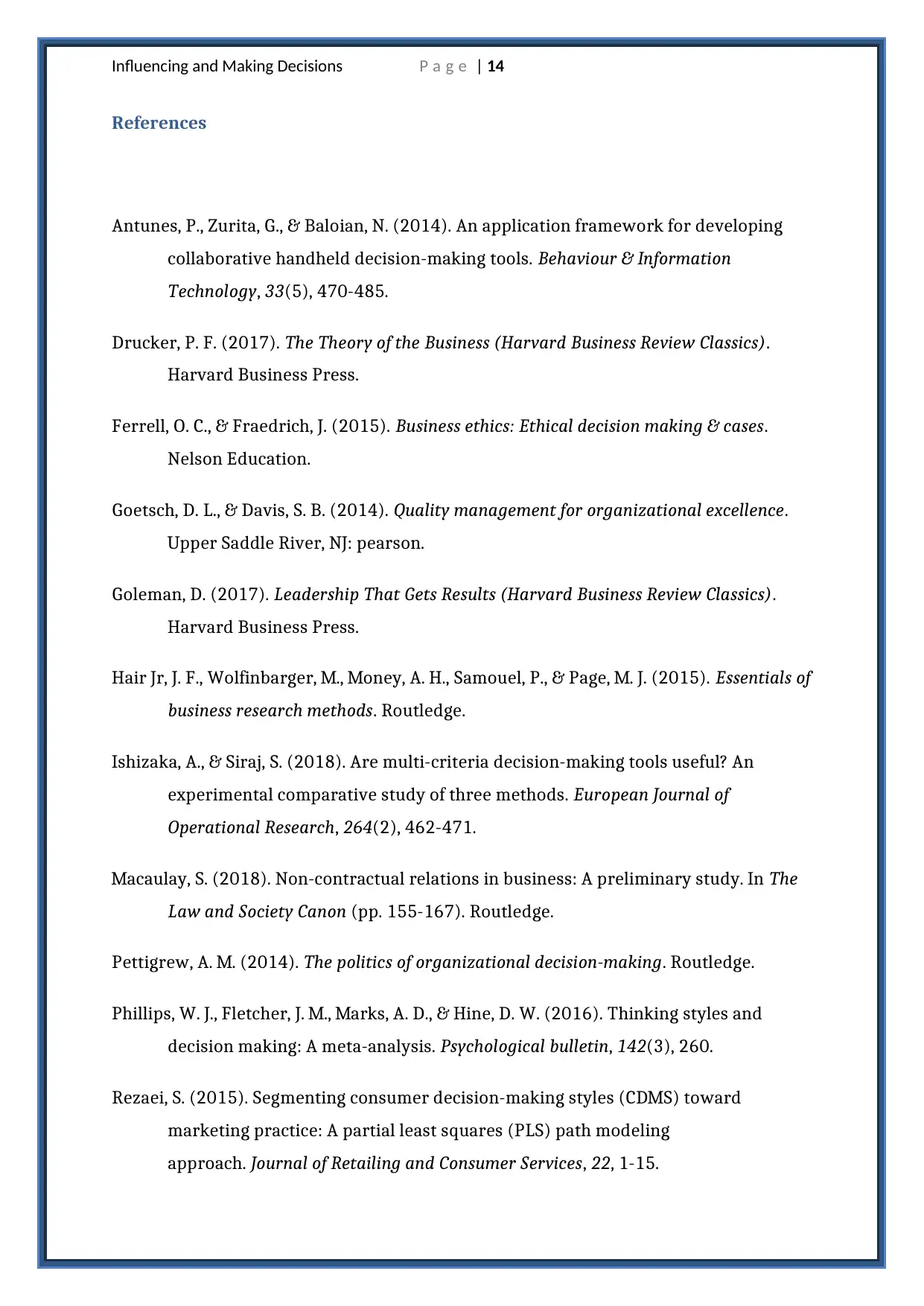
Influencing and Making Decisions P a g e | 14
References
Antunes, P., Zurita, G., & Baloian, N. (2014). An application framework for developing
collaborative handheld decision-making tools. Behaviour & Information
Technology, 33(5), 470-485.
Drucker, P. F. (2017). The Theory of the Business (Harvard Business Review Classics).
Harvard Business Press.
Ferrell, O. C., & Fraedrich, J. (2015). Business ethics: Ethical decision making & cases.
Nelson Education.
Goetsch, D. L., & Davis, S. B. (2014). Quality management for organizational excellence.
Upper Saddle River, NJ: pearson.
Goleman, D. (2017). Leadership That Gets Results (Harvard Business Review Classics).
Harvard Business Press.
Hair Jr, J. F., Wolfinbarger, M., Money, A. H., Samouel, P., & Page, M. J. (2015). Essentials of
business research methods. Routledge.
Ishizaka, A., & Siraj, S. (2018). Are multi-criteria decision-making tools useful? An
experimental comparative study of three methods. European Journal of
Operational Research, 264(2), 462-471.
Macaulay, S. (2018). Non-contractual relations in business: A preliminary study. In The
Law and Society Canon (pp. 155-167). Routledge.
Pettigrew, A. M. (2014). The politics of organizational decision-making. Routledge.
Phillips, W. J., Fletcher, J. M., Marks, A. D., & Hine, D. W. (2016). Thinking styles and
decision making: A meta-analysis. Psychological bulletin, 142(3), 260.
Rezaei, S. (2015). Segmenting consumer decision-making styles (CDMS) toward
marketing practice: A partial least squares (PLS) path modeling
approach. Journal of Retailing and Consumer Services, 22, 1-15.
References
Antunes, P., Zurita, G., & Baloian, N. (2014). An application framework for developing
collaborative handheld decision-making tools. Behaviour & Information
Technology, 33(5), 470-485.
Drucker, P. F. (2017). The Theory of the Business (Harvard Business Review Classics).
Harvard Business Press.
Ferrell, O. C., & Fraedrich, J. (2015). Business ethics: Ethical decision making & cases.
Nelson Education.
Goetsch, D. L., & Davis, S. B. (2014). Quality management for organizational excellence.
Upper Saddle River, NJ: pearson.
Goleman, D. (2017). Leadership That Gets Results (Harvard Business Review Classics).
Harvard Business Press.
Hair Jr, J. F., Wolfinbarger, M., Money, A. H., Samouel, P., & Page, M. J. (2015). Essentials of
business research methods. Routledge.
Ishizaka, A., & Siraj, S. (2018). Are multi-criteria decision-making tools useful? An
experimental comparative study of three methods. European Journal of
Operational Research, 264(2), 462-471.
Macaulay, S. (2018). Non-contractual relations in business: A preliminary study. In The
Law and Society Canon (pp. 155-167). Routledge.
Pettigrew, A. M. (2014). The politics of organizational decision-making. Routledge.
Phillips, W. J., Fletcher, J. M., Marks, A. D., & Hine, D. W. (2016). Thinking styles and
decision making: A meta-analysis. Psychological bulletin, 142(3), 260.
Rezaei, S. (2015). Segmenting consumer decision-making styles (CDMS) toward
marketing practice: A partial least squares (PLS) path modeling
approach. Journal of Retailing and Consumer Services, 22, 1-15.
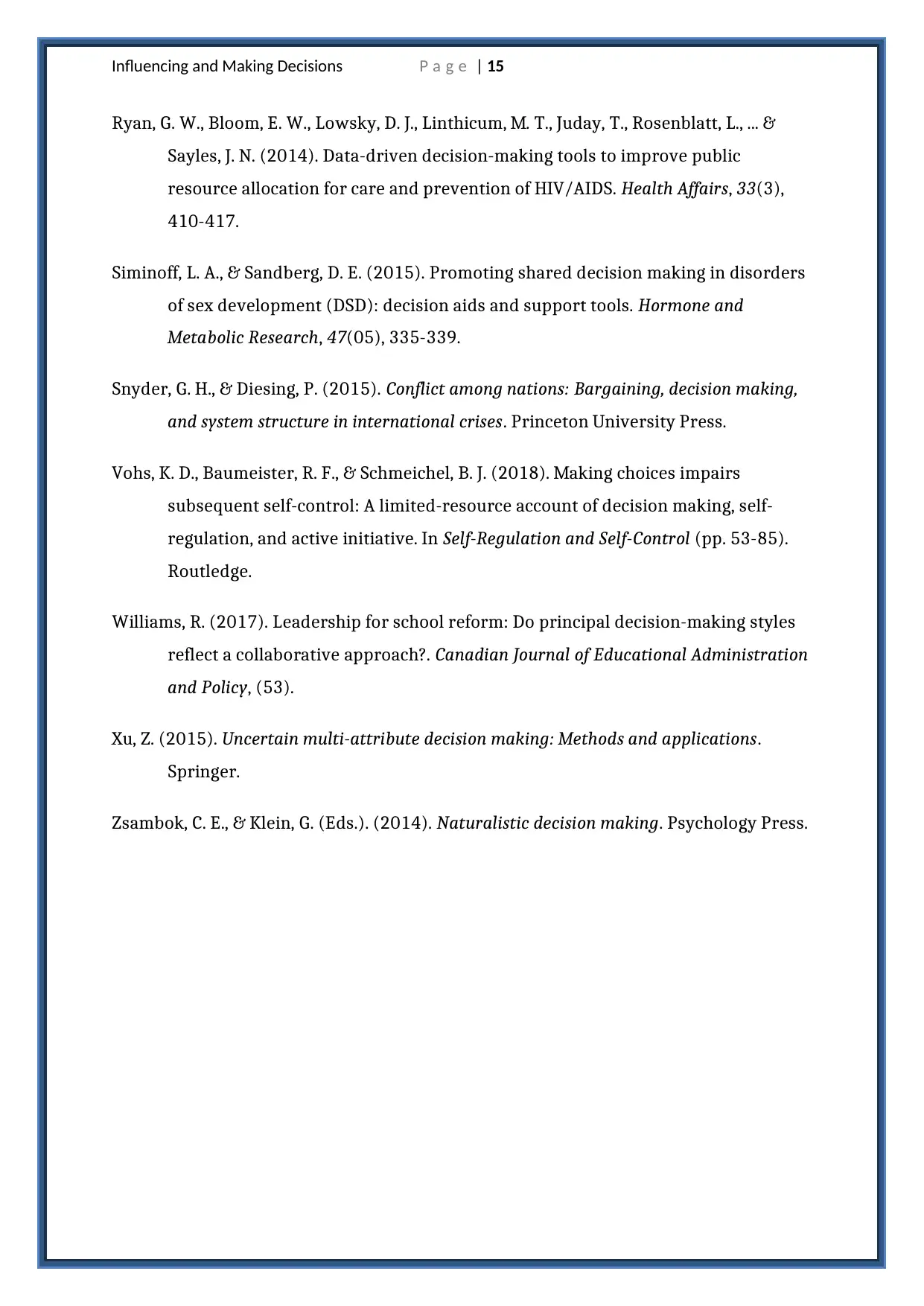
Influencing and Making Decisions P a g e | 15
Ryan, G. W., Bloom, E. W., Lowsky, D. J., Linthicum, M. T., Juday, T., Rosenblatt, L., ... &
Sayles, J. N. (2014). Data-driven decision-making tools to improve public
resource allocation for care and prevention of HIV/AIDS. Health Affairs, 33(3),
410-417.
Siminoff, L. A., & Sandberg, D. E. (2015). Promoting shared decision making in disorders
of sex development (DSD): decision aids and support tools. Hormone and
Metabolic Research, 47(05), 335-339.
Snyder, G. H., & Diesing, P. (2015). Conflict among nations: Bargaining, decision making,
and system structure in international crises. Princeton University Press.
Vohs, K. D., Baumeister, R. F., & Schmeichel, B. J. (2018). Making choices impairs
subsequent self-control: A limited-resource account of decision making, self-
regulation, and active initiative. In Self-Regulation and Self-Control (pp. 53-85).
Routledge.
Williams, R. (2017). Leadership for school reform: Do principal decision-making styles
reflect a collaborative approach?. Canadian Journal of Educational Administration
and Policy, (53).
Xu, Z. (2015). Uncertain multi-attribute decision making: Methods and applications.
Springer.
Zsambok, C. E., & Klein, G. (Eds.). (2014). Naturalistic decision making. Psychology Press.
Ryan, G. W., Bloom, E. W., Lowsky, D. J., Linthicum, M. T., Juday, T., Rosenblatt, L., ... &
Sayles, J. N. (2014). Data-driven decision-making tools to improve public
resource allocation for care and prevention of HIV/AIDS. Health Affairs, 33(3),
410-417.
Siminoff, L. A., & Sandberg, D. E. (2015). Promoting shared decision making in disorders
of sex development (DSD): decision aids and support tools. Hormone and
Metabolic Research, 47(05), 335-339.
Snyder, G. H., & Diesing, P. (2015). Conflict among nations: Bargaining, decision making,
and system structure in international crises. Princeton University Press.
Vohs, K. D., Baumeister, R. F., & Schmeichel, B. J. (2018). Making choices impairs
subsequent self-control: A limited-resource account of decision making, self-
regulation, and active initiative. In Self-Regulation and Self-Control (pp. 53-85).
Routledge.
Williams, R. (2017). Leadership for school reform: Do principal decision-making styles
reflect a collaborative approach?. Canadian Journal of Educational Administration
and Policy, (53).
Xu, Z. (2015). Uncertain multi-attribute decision making: Methods and applications.
Springer.
Zsambok, C. E., & Klein, G. (Eds.). (2014). Naturalistic decision making. Psychology Press.
1 out of 16
Related Documents
Your All-in-One AI-Powered Toolkit for Academic Success.
+13062052269
info@desklib.com
Available 24*7 on WhatsApp / Email
![[object Object]](/_next/static/media/star-bottom.7253800d.svg)
Unlock your academic potential
© 2024 | Zucol Services PVT LTD | All rights reserved.





